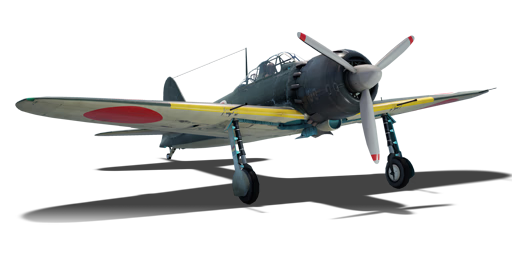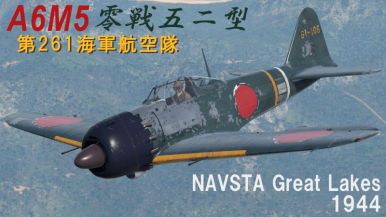



The A6M5 mod. 52, designated as the Type 0 Carrier-based Fighter Model 52 (零式艦上戦闘機五二型), was the last main-production variant of the A6M series. The wings were redesigned once again, cutting to the same length as that of the A6M3 mod. 32 but rounding out the tips. Aside from that, the engine performance was improved due to the modification of the Sakae engine's exhaust system to point the stacks aft and distributing them around the forward fuselage, providing an additional increase in thrust. Armour protection for the pilot and fuel tanks was increased, and self-sealing fuel tanks were included in later production. The A6M5 mod. 52 retained the armament of the A6M3 mod. 22A (Ko) which fielded the better Type 99 Model 2 (20 mm) over earlier A6Ms.
It has been in the game since the start of the Open Beta Test prior to Update 1.27. With all the modifications done to the A6M5 over the other A6Ms, performance has improved but it faces stronger enemy aircraft which proportionally perform even better. While still unrivalled in manoeuvre dogfights, capable of dodging, weaving, and out-turning the pursuer into getting on their six, staying on the six of an aircraft will be harder to maintain due to the higher top speeds all other aircraft will have over the A6M5. As the last main-production A6M, the A6M5s also come with a late-war modification which allow them to be converted into "bakusen", mounting a 250 kg bomb in place of the centreline drop tank.
flaps
flaps
flaps
brake
| Belt | Belt filling | Armor penetration (mm) at a distance: | |||||
|---|---|---|---|---|---|---|---|
| 10 m | 100 m | 500 m | 1000 m | 1500 m | 2000 m | ||
| T/FI/FI/APHE | 26 | 24 | 17 | 10 | 6 | 4 | |
| HEF-T/HEF/HEF/APHE | 26 | 24 | 17 | 10 | 6 | 4 | |
| APHE/APHE/APHE/APHE/HEF/HEF-T | 26 | 24 | 17 | 10 | 6 | 4 | |
| HEF-T | 4 | 4 | 4 | 4 | 4 | 4 | |
| HEF/HEF/HEF/APHE/APHE | 26 | 24 | 17 | 10 | 6 | 4 | |
| Belt | Belt filling | Armor penetration (mm) at a distance: | |||||
|---|---|---|---|---|---|---|---|
| 10 m | 100 m | 500 m | 1000 m | 1500 m | 2000 m | ||
| T/AP/IAI/AP/I | 13 | 12 | 7 | 3 | 2 | 0 | |
| T/AP/IAI/AP | 13 | 12 | 7 | 3 | 2 | 0 | |
| T/T/T/AP | 13 | 12 | 7 | 3 | 2 | 0 | |
| I/AP/AP/AP/IAI | 13 | 12 | 7 | 3 | 2 | 0 | |












Flight performance | |
|---|---|
Survivability |
|---|
Weaponry | |
|---|---|
